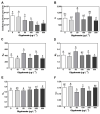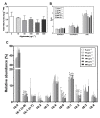Effects of Glyphosate-Based Herbicide on Primary Production and Physiological Fitness of the Macroalgae Ulva lactuca
- PMID: 36006109
- PMCID: PMC9415031
- DOI: 10.3390/toxics10080430
Effects of Glyphosate-Based Herbicide on Primary Production and Physiological Fitness of the Macroalgae Ulva lactuca
Abstract
The use of glyphosate-based herbicides (GBHs) worldwide has increased exponentially over the last two decades increasing the environmental risk to marine and coastal habitats. The present study investigated the effects of GBHs at environmentally relevant concentrations (0, 10, 50, 100, 250, and 500 μg·L-1) on the physiology and biochemistry (photosynthesis, pigment, and lipid composition, antioxidative systems and energy balance) of Ulva lactuca, a cosmopolitan marine macroalgae species. Although GBHs cause deleterious effects such as the inhibition of photosynthetic activity, particularly at 250 μg·L-1, due to the impairment of the electron transport in the chloroplasts, these changes are almost completely reverted at the highest concentration (500 μg·L-1). This could be related to the induction of tolerance mechanisms at a certain threshold or tipping point. While no changes occurred in the energy balance, an increase in the pigment antheraxanthin is observed jointly with an increase in ascorbate peroxidase activity. These mechanisms might have contributed to protecting thylakoids against excess radiation and the increase in reactive oxygen species, associated with stress conditions, as no increase in lipid peroxidation products was observed. Furthermore, changes in the fatty acids profile, usually attributed to the induction of plant stress response mechanisms, demonstrated the high resilience of this macroalgae. Notably, the application of bio-optical tools in ecotoxicology, such as pulse amplitude modulated (PAM) fluorometry and laser-induced fluorescence (LIF), allowed separation of the control samples and those treated by GBHs in different concentrations with a high degree of accuracy, with PAM more accurate in identifying the different treatments.
Keywords: energetic metabolism; glyphosate; oxidative stress; pesticide; photobiology.
Conflict of interest statement
The authors declare no conflict of interest.
Figures










Similar articles
-
Ecotoxicological Effects of the Anionic Surfactant Sodium Dodecyl Sulfate (SDS) in Two Marine Primary Producers: Phaeodactylum tricornutum and Ulva lactuca.Toxics. 2022 Dec 13;10(12):780. doi: 10.3390/toxics10120780. Toxics. 2022. PMID: 36548613 Free PMC article.
-
Concerns over use of glyphosate-based herbicides and risks associated with exposures: a consensus statement.Environ Health. 2016 Feb 17;15:19. doi: 10.1186/s12940-016-0117-0. Environ Health. 2016. PMID: 26883814 Free PMC article.
-
Accumulation and effects of metal mixtures in two seaweed species.Comp Biochem Physiol C Toxicol Pharmacol. 2015 May;171:28-33. doi: 10.1016/j.cbpc.2015.03.005. Epub 2015 Mar 23. Comp Biochem Physiol C Toxicol Pharmacol. 2015. PMID: 25814321
-
Disturbance of cellular calcium homeostasis plays a pivotal role in glyphosate-based herbicide-induced oxidative stress.Environ Sci Pollut Res Int. 2023 Jan;30(4):9082-9102. doi: 10.1007/s11356-022-24361-2. Epub 2022 Nov 28. Environ Sci Pollut Res Int. 2023. PMID: 36441326 Review.
-
Are glyphosate and glyphosate-based herbicides endocrine disruptors that alter female fertility?Mol Cell Endocrinol. 2020 Dec 1;518:110934. doi: 10.1016/j.mce.2020.110934. Epub 2020 Jul 10. Mol Cell Endocrinol. 2020. PMID: 32659439 Review.
Cited by
-
Photosynthesis Responses of Tibetan Freshwater Algae Chlorella vulgaris to Herbicide Glyphosate.Int J Environ Res Public Health. 2022 Dec 26;20(1):386. doi: 10.3390/ijerph20010386. Int J Environ Res Public Health. 2022. PMID: 36612715 Free PMC article.
-
Ecotoxicological Effects of the Anionic Surfactant Sodium Dodecyl Sulfate (SDS) in Two Marine Primary Producers: Phaeodactylum tricornutum and Ulva lactuca.Toxics. 2022 Dec 13;10(12):780. doi: 10.3390/toxics10120780. Toxics. 2022. PMID: 36548613 Free PMC article.
-
The green tide causative-species Ulva prolifera responding to exposure to oil and dispersant.Heliyon. 2024 Apr 16;10(9):e29641. doi: 10.1016/j.heliyon.2024.e29641. eCollection 2024 May 15. Heliyon. 2024. PMID: 38698977 Free PMC article.
References
-
- Percy S., Lubchenco J., Almeida F., Armsworth P., Bennett A., Ebi K., Ehrmann J., Griffith J., Kumar P., Pagiola S., et al. Ecosystems and Human Well-Being. World Resources Institute; Washington, DC, USA: 2005. [(accessed on 3 February 2022)]. 36p. A Report of the Millennium Ecosystem Assessment. Available online: https://www.millenniumassessment.org/documents/document.353.aspx.pdf.
-
- CAS CAS Assigns the 100 Millionth CAS Registry Number® to a Substance Designed to Treat Acute Myeloid Leukemia. 2015. [(accessed on 3 February 2022)]. Available online: https://web.archive.org/web/20150822051043/http://www.cas.org/news/media....
-
- Thomaidis N.S., Asimakopoulos A.G., Bletsou A.A. Emerging contaminants: A tutorial mini-review. Glob. Nest J. 2012;14:72–79.
Grants and funding
LinkOut - more resources
Full Text Sources
Miscellaneous

